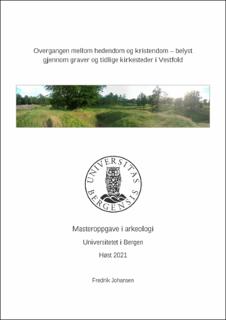Overgangen mellom hedendom og kristendom - belyst gjennom graver og tidlige kirkesteder i Vestfold
Master thesis
Permanent lenke
https://hdl.handle.net/11250/2837508Utgivelsesdato
2021-11-23Metadata
Vis full innførselSamlinger
- Master theses [240]
Sammendrag
This thesis discusses the transition from heathenism to Christianity in Vestfold, with focus on three burial grounds: Borre, Gulli and Kaupang, and the earliest churches in the region. This study will address multiple things. First, do we find any Christian indications in the pre-Christian graves at the three burial grounds, and if so: why? Also, when does the pagan burial customs end? Second, how can the oldest churches in Vestfold help us understand the religious transition? Thirdly, can the proximity between the oldest churches and pagan burial sites and/or cult sites shed light on the possible continuity of cult or power? In all the three burial grounds I was able to find only one definite Christian item, a silver crucifix pendant in Kaupang. With status as a trading settlement, it is possible that Kaupang can have had Christian visitors. With regards to the pagan burial customs, it seems to cease the earliest at Borre, at around 900-950 AD, with Gulli and Kaupang close behind at around 1000 AD. Out of the 18 churches in Vestfold build in 1200 AD or earlier, 17 of them are build close to, or on top of older pagan burial sites or cult sites, which in many cases suggests a level of continuity of cult, and in some cases continuity of power. It did not seem as though some parts of the region were Christianized before others, although local variations did occur.
